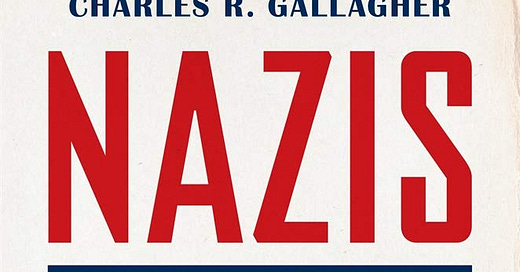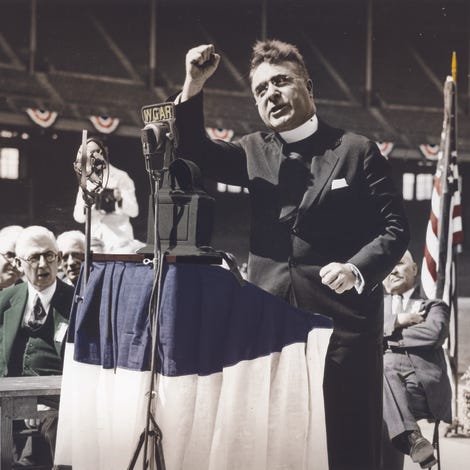In my recent post on the French lay philosopher Yves Simon, I discussed his lonely interwar efforts to encourage fellow Catholics to abandon their attachment to the proto-fascist socio-political movement Action Française (AF) and rally in support of the embattled Third French Republic during the 1930s. This call to ralliement echoed the one that had been made by Pope Leo XIII in 1892, just one year after the publication of the first modern social encyclical, Rerum novarum: On Capital and Labor. Like Leo’s earlier effort that was overtaken by the modernist crisis and anti-modernist reaction, Simon’s call went unheeded and French Catholics instead continued tragically down “The Road to Vichy.”
From this prior discussion of the alignment of European Catholics with fascism during the interwar years, one might be left with the impression that there was not a similar problem among American Catholics. This, unfortunately, would be far from the truth. In this post, therefore, I will briefly introduce some of the recent literature regarding a similar situation in the United States that has been largely forgotten, much like the one about which Simon wrote. In the United States, the problem of fascism faded into the background after the Japanese attack on the American naval fleet at Pearl Harbor, which brought us into the war against the Axis powers. Given the contemporary rise of authoritarianism, however, this history is being recovered.
Gallagher on the Nazis of Copley Square
An important example of this recent literature is The Nazis of Copley Square: The Forgotten Story of the Christian Front, which was published in 2021 by the Jesuit historian Charles R. Gallagher of Boston College. It tells the shocking story of a militaristic, anticommunist and antisemitic group of Catholics that was founded in 1938 under the inspiration of the demagogic and Nazi-sympathizing radio priest Fr. Charles Coughlin.
The synopsis of the book reads as follows:
The forgotten history of American terrorists who, in the name of God, conspired to overthrow the government and formed an alliance with Hitler.
On January 13, 1940, FBI agents burst into the homes and offices of seventeen members of the Christian Front, seizing guns, ammunition, and homemade bombs. J. Edgar Hoover’s charges were incendiary: the group, he alleged, was planning to incite a revolution and install a “temporary dictatorship” in order to stamp out Jewish and Communist influence in the United States. Interviewed in his jail cell, the front’s ringleader was unbowed: “All I can say is―long live Christ the King! Down with Communism!”
In Nazis of Copley Square, Charles Gallagher provides a crucial missing chapter in the history of the American far right. The men of the Christian Front imagined themselves as crusaders fighting for the spiritual purification of the nation, under assault from godless Communism, and they were hardly alone in their beliefs. The front traced its origins to vibrant global Catholic theological movements of the early twentieth century, such as the Mystical Body of Christ and Catholic Action. The front’s anti-Semitism was inspired by Sunday sermons and by lay leaders openly espousing fascist and Nazi beliefs.
Gallagher chronicles the evolution of the front, the transatlantic cloak-and-dagger intelligence operations that subverted it, and the mainstream political and religious leaders who shielded the front’s activities from scrutiny. Nazis of Copley Square is a grim tale of faith perverted to violent ends, and a warning for those who hope to curb the spread of far-right ideologies today.
One of the more disturbing aspects of this story is that, although the Christian Fronters were arrested by the FBI before they were able to carry out the plot, the prosecution failed, for several reasons. These included a political decision by the prosecution to downplay the religious motivations of the Christian Front, which made the case unpersuasive. This allowed the Nazi sympathies and collaboration by American Catholics to be forgotten by history. Gallagher’s historical narrative sets the record straight and shows that support for fascism, Nazism, and antisemitism among American Catholics was significant during the interwar years, much as it was in Europe.
I bring this up not merely as a historical artifact, but as a warning given the fact that a significant portion of American Catholics are still supporting a Republican party that is now accurately described as anti-democratic, at least proto-fascist and authoritarian. I do so also in support of American Catholics who are rightly understanding our social tradition to encourage us to protect and renew our constitutional democracy. Those interested in further understanding the Christian Front can find nicely-illustrated PowerPoint lectures by Gallagher here and here.
Further Considerations on American Catholic Sympathy for Fascism
It was not simply the case, however, that Americans were corrupted by Nazi ideology. American race laws and practices were also a significant inspiration for Nazi racial ideology as James Q. Whitman shows in his 2017 Hitler's American Model: The United States and the Making of Nazi Race Law published by Princeton University Press.
The synopsis reads as follows:
Nazism triumphed in Germany during the high era of Jim Crow laws in the United States. Did the American regime of racial oppression in any way inspire the Nazis? The unsettling answer is yes. In Hitler's American Model, James Whitman presents a detailed investigation of the American impact on the notorious Nuremberg Laws, the centerpiece anti-Jewish legislation of the Nazi regime. Contrary to those who have insisted that there was no meaningful connection between American and German racial repression, Whitman demonstrates that the Nazis took a real, sustained, significant, and revealing interest in American race policies.
As Whitman shows, the Nuremberg Laws were crafted in an atmosphere of considerable attention to the precedents American race laws had to offer. German praise for American practices, already found in Hitler's Mein Kampf, was continuous throughout the early 1930s, and the most radical Nazi lawyers were eager advocates of the use of American models. But while Jim Crow segregation was one aspect of American law that appealed to Nazi radicals, it was not the most consequential one. Rather, both American citizenship and antimiscegenation laws proved directly relevant to the two principal Nuremberg Laws―the Citizenship Law and the Blood Law. Whitman looks at the ultimate, ugly irony that when Nazis rejected American practices, it was sometimes not because they found them too enlightened, but too harsh.
Indelibly linking American race laws to the shaping of Nazi policies in Germany, Hitler's American Model upends understandings of America's influence on racist practices in the wider world.
In a future post, I will discuss some of the more remote roots behind this warped thinking. I will argue that such thinking in the United States traces to an ideology that has been present since before the founding, namely the view that some persons—namely white, property owning males—are better than others and should rule, while others are inferior to them and should be ruled. I see all these evils as tracing back to a fundamental insight of St. Augustine in his City of God, namely the libido dominandi, the lust to dominate that marks fallen humanity.








Those who forget (or never learn) their history are bound to repeat it. Thanks for not letting us forget.